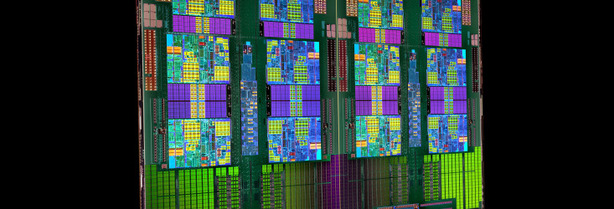Up Close: AMD Opteron 6000-series
The Opteron 6000-series marks the first major revision of the Opteron family for quite a few years, as AMD was keen to retain backwards compatibility with its earlier workstation/server processors. Thus while, theoretically speaking, you could upgrade all the way from a dual-core Opteron 2200-series to a 6-core Opteron 2400-series without changing motherboard, you will actually need a new motherboard if you want to use a pair of the new Opteron 6000-series.This is because the new Opteron 6000-series processors use a new packaging type, known as G34. G34 is considerably larger than Socket F, being LGA1944 rather than LGA1207. In fact, the Opteron 6174s that we tested are the largest CPUs we’ve seen since the Pentium Pro way back in 1995 - it's a seriously wide and large chip.
The reason for the huge increase in physical size is that AMD has doubled the number of cores from six to 12. Yes, that’s right; the high-end models of the Opteron 6000-series have 12 physical cores. This means that a dual-processor system will have 24 physical cores and a quad-processor system will have 48 physical cores. In comparison, a dual-processor Xeon 5600-series system will also have 24 cores, but 12 of these will be logical Hyper-Threaded cores, not actual physical cores.
However, as the die shot below reveals, AMD hasn’t come up with the first native 12 core CPU, instead it's sandwiched two 45nm 6-core dies together in one package, known as Magny-Cours. Like the Xeon 5600-series, not every Magny-Cours chip has 12 cores. The table at the bottom of this page summarises the principle differences between the various models, but suffice to say, some models only have eight cores, not 12, so be careful what you buy.

A close-up of the 12-core Magny-Cours die at the heart of the Opteron 6000-series. Click to enlarge.
In addition to doubling the core count, AMD has also added several more HyperTransport 3 links so that each CPU socket on the motherboard can better communicate with one another. The extra links should dramatically improve performance in quad-processors systems as the CPUs will now be able to talk to each directly, rather than having to shuffle data around the motherboard. Whereas the previous-generation Opterons only supported 800MHz dual-channel DDR2, Magny-Cours processors effectively each have a quad-channel registered 1,333MHz ECC DDR3 memory controller. This provides far greater bandwidth than earlier designs and means for the first time ever that Opterons and Xeons use the same memory technology (DDR3). However, it does mean you should install memory in multiples of four for the best performance.
AMD has also made some minor improvements to the underlying K10 architecture, though just like when it launched Phenom II, AMD won’t go into detail about what these are. The cache architecture of Magny-Cours however is identical to earlier Opterons, with 128KB Level 1 cache per core, 512KB of Level 2 cache per core and 12MB of shared Level 3 cache.
In conjunction with the Opteron 6000-series AMD has also developed several new motherboard chipsets, the SR5670 and SR5690. The latter is optimised for quad-processor systems and workstations as it has 42 hot-swappable PCI-E 2.0 lanes. In contrast, the SR5670 has 30 standard PCI-E 2.0 lanes, so it will be the chipset you’ll find on most server motherboards. AMD has also developed a workstation/server version of the SB700 chipset, known as SP5100, although it still lacks features such as SATA 6Gbps and USB 3.
AMD has also taken the opportunity to change how it brands and sells Opteron. In the past, there were three distinct types of Opteron; those with a name starting with a 1 only worked in a single-processor configuration, with those starting with a 2 only worked in a dual-processor system and those starting with an 8 were required for quad- or octo-socket motherboards. In contrast, all Opteron 6000-series CPUs can work in dual and quad-socket motherboards. This not only makes it easier to choose what to buy, but simplifies the supply chain, making it easier for AMD, motherboard manufacturers and distributors to keep the price down and develop new models.
AMD has also announced a range of lower-cost single- and dual-processor Magny-Cours CPUs, known as the Opteron 4000-series. Although we’ve yet to see any of these in the flesh we do know that the Opteron 4000-series CPUs will be smaller, making use of a new LGA1207 C32 socket and will have either four or eight cores, two fewer HyperTransport 3 links and a dual-channel DDR3 memory controller. You can also expect to find these CPUs at a significantly lower price than their Opteron 6000-series brethren.
| Model | Frequency | Physical cores | ACP | DDR3 support | List Price |
| 6176 SE | 2.3GHz | 12 | 105W | 1,333, 1066, 800 | $1,386 |
| 6174 | 2.2GHz | 12 | 80W | 1,333, 1066, 800 | $1,165 |
| 6172 | 2.1GHz | 12 | 80W | 1,333, 1066, 800 | $989 |
| 6168 | 1.9GHz | 12 | 80W | 1,333, 1066, 800 | $744 |
| 6136 | 2.4GHz | 8 | 80W | 1,333, 1066, 800 | $744 |
| 6134 | 2.3GHz | 8 | 80W | 1,333, 1066, 800 | $523 |
| 6128 | 2GHz | 8 | 80W | 1,333, 1066, 800 | $266 |
| 6164 HE | 1.7GHz | 12 | 65W | 1,333, 1066, 800 | $724 |
| 6128 HE | 2GHz | 8 | 65W | 1,333, 1066, 800 | $523 |
| 6124 HE | 1.8GHz | 8 | 65W | 1,333, 1066, 800 | $455 |

MSI MPG Velox 100R Chassis Review
October 14 2021 | 15:04









Want to comment? Please log in.